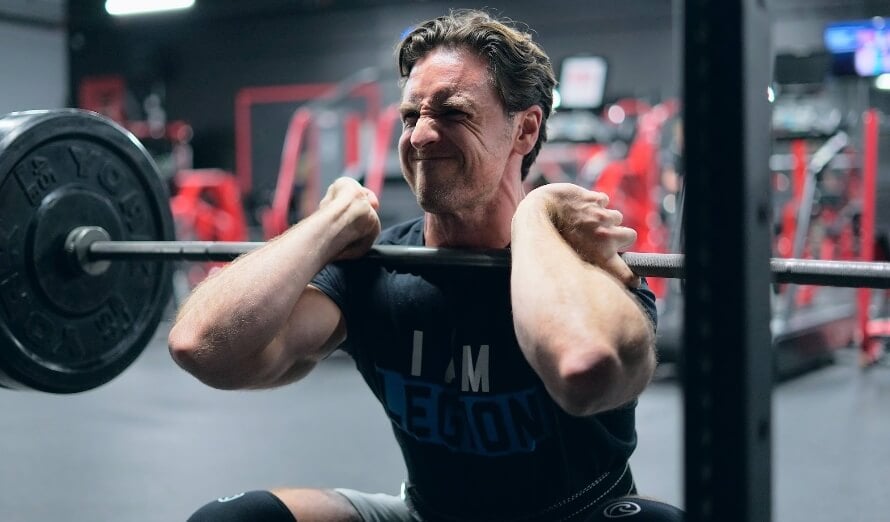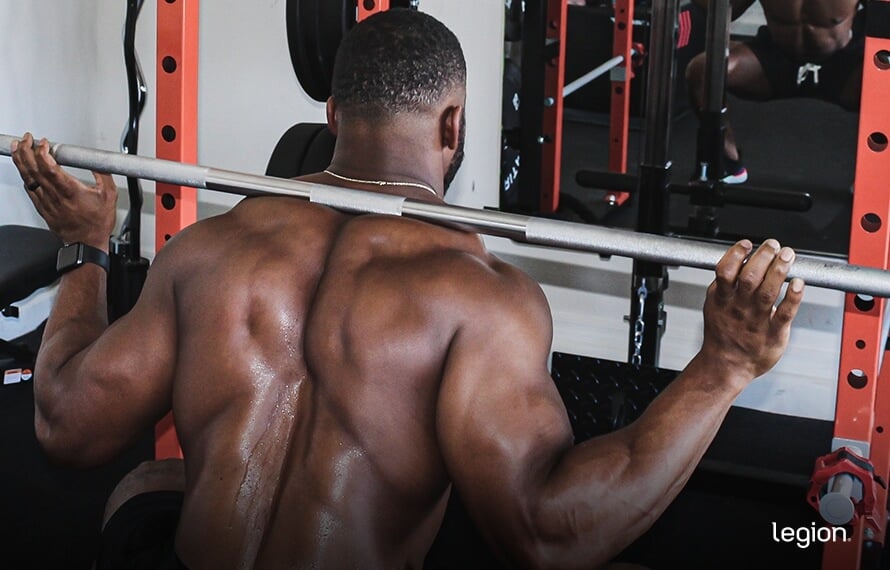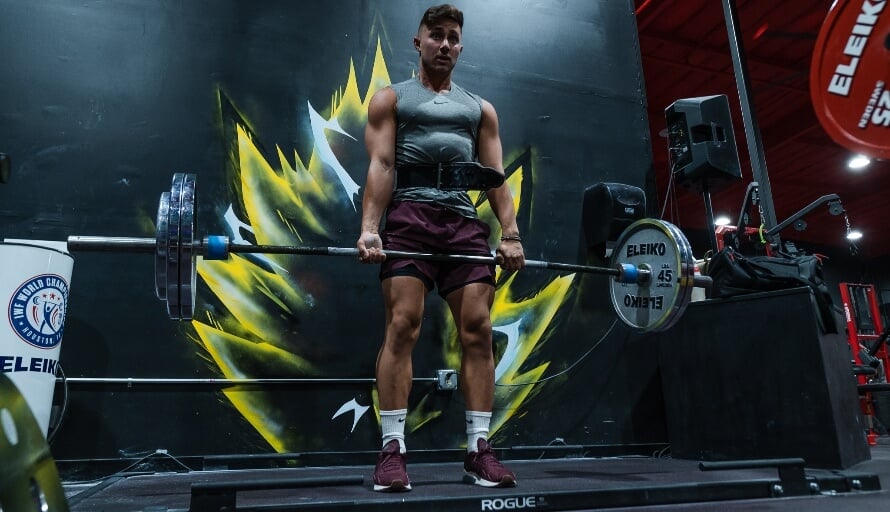The PHAT (Power Hypertrophy Adaptive Training) workout is a 5-day training routine that combines powerlifting and bodybuilding to help you build muscle and strength quickly.
PHAT was created by accomplished powerlifter and bodybuilder Dr. Layne Norton, who designed it to merge the best aspects of strength and hypertrophy training into a single program.
Each week, you train every major muscle group twice—once with heavy weights in low rep ranges to build strength, and again with lighter, high-volume training to maximize muscle growth.
In this guide, you’ll learn exactly how the PHAT program works, how to follow it, and what to do if your progress stalls.
Want to know exactly how you should train to reach your fitness goals? Take our free 60-second training quiz and find out now.
Key Takeaways
- The PHAT (Power Hypertrophy Adaptive Training) workout routine is a 5-day strength training program developed by Dr. Layne Norton to help you gain muscle and strength simultaneously.
- Each week includes two power workouts (heavy weights, low reps) and three hypertrophy workouts (lighter weights, higher reps, and more sets).
- PHAT uses daily undulating periodization—a method proven to boost size and strength—and trains each muscle group twice per week with a strong emphasis on progressive overload.
- To accelerate your progress on the PHAT workout program, use a high-quality protein powder to hit your daily protein target, creatine to boost recovery and growth, and a pre-workout to enhance energy, focus, and performance.
- If your progress stalls, adjust your exercise selection to target weak points or take a deload.
What Is the PHAT Workout Routine?

The PHAT workout routine is a 5-day strength training program developed by Dr. Layne Norton.
PHAT stands for Power Hypertrophy Adaptive Training and refers to a workout program that combines powerlifting and bodybuilding to help you gain both muscle size (hypertrophy) and strength simultaneously.
PHAT Workout Schedule
You’ll find dozens of PHAT workout variations online, but most follow the same basic structure. You start the week with two “power” days focused on upper and lower body strength. After a rest day, you then do three days of bodybuilding-style hypertrophy training.
Here’s what a typical PHAT week looks like:
- Day 1: Upper Body Power
- Day 2: Lower Body Power
- Day 3: Rest
- Day 4: Back and Shoulders Hypertrophy
- Day 5: Lower Body Hypertrophy
- Day 6: Chest and Arms Hypertrophy
- Day 7: Rest
PHAT Workout Principles

Let’s take a closer look at the main principles behind Layne Norton’s PHAT program and what each workout involves.
Power Workouts
Each week begins with two power workouts: one for the upper body and another for the lower body. In these workouts, you perform one main compound exercise to train upper-body pushing, one for upper-body pulling, and one for the lower body.
For example, you might do a bench press (upper-body push), a barbell row (upper-body pull), and a squat or deadlift (lower body). Unlike most programs, PHAT rotates these main exercises every 2–3 weeks to help you keep progressing.
For each main exercise, you do 3–5 sets of 3–5 reps, resting as long as needed between sets—up to 6 minutes if that’s what it takes for you to fully recoup your strength.
After your main exercises, you do 1–2 “assistance exercises” to improve your performance on the main movements, followed by 1–2 “auxiliary exercises” to target smaller muscle groups that may not otherwise get sufficiently stimulated—like your hamstrings, calves, shoulders, and arms.
Hypertrophy Workouts
Each hypertrophy day starts with “speed” training using the same compound exercise you trained heavy earlier in the week. For these, you do 6–8 sets of 3 reps at around 65–70% of the weight you used for your power sets.
For example, if you squatted 300 pounds for 3–5 reps earlier in the week, you’d do 6 sets of 3 with 195–210 pounds. The focus for these sets is on lifting the weight as quickly as possible—if you’re not squatting the weights explosively, you’re trying to lift too much weight.
Rest no more than 90 seconds between speed sets.
After the speed work, the rest of the session follows a traditional bodybuilding format: 8–20 reps per set, 1–2 minutes rest, and significantly more volume (sets) than your power days.
In this portion of the workout, stop each set 1–2 reps shy of failure—the point where you can’t complete another rep with good form despite giving full effort.
The PHAT Workout Routine

Here’s the PHAT routine in full, including information on exercises, sets, reps, and rest times.
Upper Body Power Day
Lower Body Power Day
Back and Shoulders Hypertrophy Day
- Bent Over or Pendlay Row: 6 sets | 3 reps | 65–70% 3–5 rep-max | ≤90 sec rest
- Rack Chin-up: 3 sets | 8–12 reps | 1–2 min rest
- Seated Cable Row: 3 sets | 8–12 reps | 1–2 min rest
- One-Arm Dumbbell Row or Shrug: 2 sets | 12–15 reps | 1–2 min rest
- Close-Grip Pulldown: 2 sets | 15–20 reps | 1–2 min rest
- Seated Dumbbell Shoulder Press: 3 sets | 8–12 reps | 1–2 min rest
- Upright Row: 2 sets | 12–15 reps | 1–2 min rest
- Dumbbell or Cable Side Lateral Raise: 3 sets | 12–20 reps | 1–2 min rest
Lower Body Hypertrophy Day
- Squat: 6 sets | 3 reps | 65–70% 3–5RM | ≤90 sec rest
- Hack Squat: 3 sets | 8–12 reps | 1–2 min rest
- Leg Press: 2 sets | 12–15 reps | 1–2 min rest
- Leg Extension: 3 sets | 15–20 reps | 1–2 min rest
- Romanian Deadlift: 3 sets | 8–12 reps | 1–2 min rest
- Lying Leg Curl: 2 sets | 12–15 reps | 1–2 min rest
- Seated Leg Curl: 2 sets | 15–20 reps | 1–2 min rest
- Donkey Calf Raise: 4 sets | 10–15 reps | 1–2 min rest
- Seated Calf Raise: 3 sets | 15–20 reps | 1–2 min rest
Chest and Arms Hypertrophy Day
- Flat Dumbbell Bench Press: 6 sets | 3 reps | 65–70% 3–5RM | ≤90 sec rest
- Incline Dumbbell Bench Press: 3 sets | 8–12 reps | 1–2 min rest
- Machine Chest Press: 3 sets | 12–15 reps | 1–2 min rest
- Incline Cable Fly: 2 sets | 15–20 reps | 1–2 min rest
- EZ-Bar Preacher Curl: 3 sets | 8–12 reps | 1–2 min rest
- Dumbbell Concentration Curl: 2 sets | 12–15 reps | 1–2 min rest
- Spider Curl: 2 sets | 15–20 reps | 1–2 min rest
- Overhead Tricep Extension: 3 sets | 8–12 reps | 1–2 min rest
- Triceps Pushdown: 2 sets | 12–15 reps | 1–2 min rest
- Cable Triceps Kickback: 2 sets | 15–20 reps | 1–2 min rest
What Are The Benefits of the PHAT Workout Plan?

The PHAT workout plan combines proven training strategies to help you build both size and strength efficiently. Here’s what makes it effective.
Effective Periodization
The PHAT split uses daily undulating periodization (DUP), which means you train the same exercises multiple times per week using different rep ranges—from low-rep strength work to high-rep hypertrophy work.
Research shows that DUP is highly effective for improving muscle growth, strength, and endurance.
READ MORE: Should You Periodize Your Workouts? The Definitive Answer, According to 26 Studies
Optimal Frequency
You train each muscle group twice per week on the PHAT workout split, which is ideal for most people looking to gain muscle and strength.
It allows you to train each muscle group often enough to stimulate growth, but also affords you enough rest between sessions to fully recover. It also helps reduce injury risk by spreading volume across the week rather than cramming it into a single session.
READ MORE: The Best Training Frequency for Building Muscle (According to 20 Studies)
Emphasis on Overload
Many programs designed to help you gain size make minor aspects of muscle growth the focus of your training. For example, they encourage you to train your muscles until they’re pumped and sore despite evidence that these aren’t particularly reliable indicators of muscle growth.
In contrast, the PHAT workout split prioritizes getting progressively stronger over time, which is paramount for gaining muscle and strength. In other words, PHAT highlights what really matters when it comes to building muscle.
READ MORE: What is a Pump in the Gym & Does It Improve Muscle Growth?
The Best Supplements for PHAT Training
If you follow the PHAT workout split, consider these three supplements to maximize growth, train hard, and recover faster:
- Protein powder: Protein powder, such as Whey+ (Legion’s whey isolate) or Casein+ (Legion’s micellar casein), provides your body with the nutrients needed to build muscle tissue and recover from your PHAT workouts.
- Creatine: Creatine boosts muscle and strength gain, improves anaerobic endurance, and reduces muscle damage and soreness from your workouts. For a natural source of creatine, try Legion’s creatine monohydrate, creatine gummies, or post-workout Recharge.
- Pre-workout: A high-quality pre-workout enhances energy, mood, and focus, increases strength and endurance, and reduces fatigue. For a top-tier pre-workout containing clinically effective doses of 6 science-backed ingredients, try Legion’s Pulse with caffeine or without.
(If you’d like even more specific advice about which supplements you should take to reach your health and fitness goals, take the Legion Supplement Finder Quiz, and in less than a minute, you’ll know exactly what supplements are right for you.)
Who Is the PHAT Workout for?

The PHAT workout is best suited to intermediate and advanced weightlifters who have at least a 1–2 years of consistent training under their belt, eat enough calories and protein to support intense training, and have the time and energy to train five days per week.
Beginners won’t get good results from the PHAT workout routine—the volume, intensity, and frequency are too high and will likely lead to burnout rather than progress.
How Long Should You Follow the PHAT Workout Program?
While Norton recommends following PHAT for at least 4 weeks, there’s no fixed timeline for running the program. How long you do PHAT largely depends on your progress and recovery.
For instance, if you’re recovering well and consistently getting stronger, you can stick with PHAT for months or even years.
If you’re feeling run-down or plateau soon after starting, however, you may need to adjust the program (e.g., reduce the overall volume), your lifestyle (e.g., sleep more), or switch to a different routine altogether.
How to Progress on the PHAT Program
The key to building muscle and getting strong is making regular progress. Here’s how to do it on the PHAT workout program.
Progressing on Power Days
To progress well on PHAT, you have to start conservatively. A good way to do this is to select weights for your power sets based on a percentage of your “training max,” not your one-rep max.
For example, let’s say your one-rep max on the squat is 225 pounds. You’d take 90% of that to get your training max—around 200 pounds. Then you’d base your working sets on percentages of that number.
In this case, if you’re aiming for 3–5 reps, you might start with 85–90% of your training max—around 170–180 pounds. That gives you room to build without grinding through week one.
From there, you’d increase the weight by 5 pounds each week as long as you complete all your reps in every set with good form. If you miss your reps two weeks in a row, drop the weight by 10% and work back up gradually.
Progressing on Hypertrophy Days
On hypertrophy days, choose a weight that lets you complete all your sets in the target rep range while staying 1–2 reps shy of failure.
Stick with that weight until you can hit all the prescribed sets and reps for two weeks in a row, then increase the weight by the smallest possible amount.
What to Do if Progress Stalls on PHAT

If your progress stalls on PHAT, the first thing Norton recommends is adjusting your exercise selection. Specifically, he suggests swapping out your main or accessory exercises for ones that target your specific weak points.
Here are some examples based on where your lifts are breaking down:
Back Squat
If you back squat stalls because . . .
Deadlift
If you deadlift stalls because . . .
Presses
If you bench press stalls because . . .
And if none of these changes help, your next step is to deload.
How to Deload on the PHAT Program
If swapping exercises and targeting weak points doesn’t get things moving again, it might be time to deload. You don’t need to schedule deloads in advance on PHAT—just take one when you feel physically or mentally worn down, which is usually every 6–12 weeks.
A deload doesn’t mean taking time off the gym entirely. Instead, stick to your usual routine, but reduce the weight to about 60–70% of what you’d normally lift.
For example, if you normally squat 300 pounds for 3 sets of 5, drop to 180–210 pounds for the same sets and reps. The goal is to give your body a break without getting out of the groove of your regular training.
Deload for 1–3 weeks depending on how long it takes you to feel fully recovered and ready to push hard again.
READ MORE: How to Deload: A Guide to Deload Weeks to Gain Muscle & Strength
FAQ #1: How long do PHAT workouts take?
PHAT workouts usually take 1–2 hours, depending on how long you take to warm up and how much rest you take between sets.
For an effective and efficient warm-up routine that works for PHAT workouts, check out this article:
The Best Way to Warm Up For Your Workouts
FAQ #2: Can you follow the PHAT program while cutting?
Norton generally doesn’t recommend following the PHAT workout program while cutting because it’s a demanding program, and recovery can be tough when you’re in a calorie deficit.
That said, you may be able to make it work if you prioritize sleep, manage your stress levels, eat plenty of protein, and take regular deloads.
READ MORE: How to Lose Body Fat and Not Muscle
FAQ #3: Can you do cardio on PHAT?
Yes, you can add cardio to PHAT—but start slowly. PHAT is a high-volume program, so you’ll want to limit cardio to once per week until your body adjusts to the rigors of the program.
Over time, you can work up to 2–3 low-intensity cardio workouts per week, such as walking, rucking, or cycling.
If you want to include high-intensity cardio (like sprints or sled pushes), keep it to 1–2 sessions per week and monitor your recovery. If your body feels overly sore or your weightlifting suffers, dial it back to just one HIIT session per week.
READ MORE: Concurrent Training: The Right Way to Combine Cardio and Strength Training
FAQ #4: How do you add deadlifts to PHAT?
Put the deadlift on your lower body power day. That said, squatting and deadlifting in the same workout is too demanding for most people, so unless you’re well adapted to PHAT, it’s better to alternate them. For example, do squats on lower body power day for a few weeks, then switch to deadlifts for a few weeks.
FAQ #5: Is PHAT for beginners?
No—the volume and intensity is overkill for most beginners. You should only try PHAT after you have at least 1–2 years of consistent training experience. Until then, a simpler program like Bigger Leaner Stronger is a better fit.
READ MORE: The Ultimate Guide to the Bigger Leaner Stronger Workout
Scientific References +
- Rhea, Matthew R., et al. “A Comparison of Linear and Daily Undulating Periodized Programs with Equated Volume and Intensity for Strength.” Journal of Strength and Conditioning Research, vol. 16, no. 2, 1 May 2002, pp. 250–255, pubmed.ncbi.nlm.nih.gov/11991778/.
- J, Prestes, et al. “Comparison between Linear and Daily Undulating Periodized Resistance Training to Increase Strength.” Journal of Strength and Conditioning Research, 1 Dec. 2009, pubmed.ncbi.nlm.nih.gov/19910831/.
- de Lima, C., et al. “Linear and Daily Undulating Resistance Training Periodizations Have Differential Beneficial Effects in Young Sedentary Women.” International Journal of Sports Medicine, vol. 33, no. 09, 4 May 2012, pp. 723–727, https://doi.org/10.1055/s-0032-1306324. Accessed 20 Nov. 2019.
- Zourdos, Michael C., et al. “Modified Daily Undulating Periodization Model Produces Greater Performance than a Traditional Configuration in Powerlifters.” Journal of Strength and Conditioning Research, vol. 30, no. 3, Mar. 2016, pp. 784–791, https://doi.org/10.1519/jsc.0000000000001165.
- “Comparison of 1 Day and 3 Days per Week of Equal-Volume… : The Journal of Strength & Conditioning Research.” LWW, 2019, journals.lww.com/nsca-jscr/Abstract/2000/08000/Comparison_of_1_Day_and_3_Days_Per_Week_of.6.aspx.
- Crewther, Blair, et al. “The Effects of Two Equal-Volume Training Protocols upon Strength, Body Composition and Salivary Hormones in Male Rugby Union Players.” Biology of Sport, vol. 33, no. 2, 6 Mar. 2016, pp. 111–116, www.ncbi.nlm.nih.gov/pmc/articles/PMC4885621/, https://doi.org/10.5604/20831862.1196511.
- Paz, G.A., et al. “Muscle Activation and Volume Load Performance of Paired Resistance Training Bouts with Differing Inter-Session Recovery Periods.” Science & Sports, vol. 36, no. 2, Apr. 2021, pp. 152–159, https://doi.org/10.1016/j.scispo.2020.02.011. Accessed 19 May 2021.
- Stokes, Tanner, et al. “Recent Perspectives Regarding the Role of Dietary Protein for the Promotion of Muscle Hypertrophy with Resistance Exercise Training.” Nutrients, vol. 10, no. 2, 7 Feb. 2018, p. 180, www.mdpi.com/2072-6643/10/2/180/pdf.
- Eckerson, Joan M., et al. “Effect of Creatine Phosphate Supplementation on Anaerobic Working Capacity and Body Weight after Two and Six Days of Loading in Men and Women.” The Journal of Strength and Conditioning Research, vol. 19, no. 4, 2005, p. 756, https://doi.org/10.1519/r-16924.1.
- Bassit, Reinaldo Abunasser, et al. “Effect of Short-Term Creatine Supplementation on Markers of Skeletal Muscle Damage after Strenuous Contractile Activity.” European Journal of Applied Physiology, vol. 108, no. 5, 3 Dec. 2009, pp. 945–955, https://doi.org/10.1007/s00421-009-1305-1.
